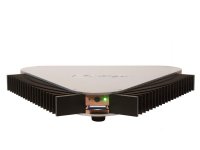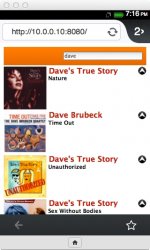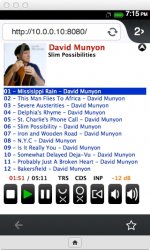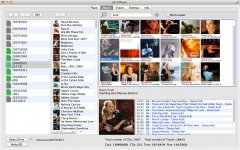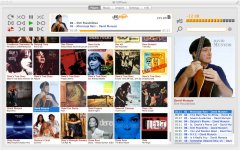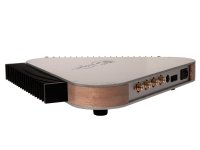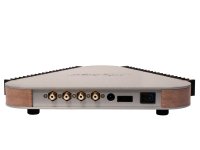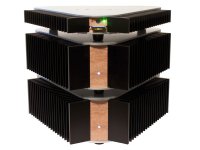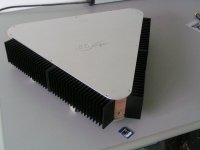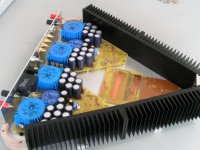Hi tiefbassuebertr,
The SD8-project was completed but another project, the SDV1-player finally replaced it (superior sound quality, up to 999 CDs on one card, lower cost).
I attached some pictures of this final SDV1-player. It contains some revolutionary circuits that offer typical Vinyl / studio tape sound quality from plain 44.1/16.
It runs on a -selected- 16 bit DAC chip (selected from a batch of 1800+ chips) that offer very low distortion, perfect channel matching and lowest possible jitter contribution.
The SDV1-player runs on an external 12V power source (adapter, battery, solar panel), so cleanest possible power source can be used. The SDV1-player requires approx. 200mA @ 12V.
It has built-in very high performance shunt volume control (based on relays & wire wound resistors), this eliminates degrading that would otherwise be introduced by the required extra external (RCA) interlinks.
The heatsinks not only offer matching design with the high resolution monoblocks, they also stabilise the chassis (mechanical vibration) and ensure a more constant temperature within the housing.
The SDV1-player runs on a novel clock source, the electronic tuning fork. This turned out to be an essential part for obtaining true "analogue" sound quality. Advantages of this clock source are eliminating cross-pollution between clock source and attached clock loads and the strong attenuation of (odd) harmonics in the clock frequency spectrum.
Novel I/V circuit is used that contains DC-bootstrapping. It fully meets DAC output compliance (6 Ohm input impedance) and offers very stable operation over a large bandwidth (300 MHz).
Apart from the pure "analogue" sound, the SDV1-player also offers a very comfortable user interface as it can be (wirelessly) controlled by computer, pad or smartphone and supports Mac, Linux, Windows, and Android. The computer software contains a built-in web server, this enables control though any wireless device containing a web browser, application is not required for this.
The SDV1-player can be controlled by an IR remote control for very basic, computer-free operation. It communicates with the outside world through light beams (slotted IR sensors) for full galvanic insulation with vanishing low coupling capacitance.
Following configurations are available:
SDV1-player > USB adapter > computer
SDV1-player > USB adapter > computer > WIFI > Wireless devices containing a web browser
SDV1-player > Bluetooth adapter > computer
SDV1-player > Bluetooth adapter > computer > WIFI > Wireless devices containing a web browser
SDV1-player > Bluetooth adapter > Android pad or smartphone (no computer required, direct communication, requires andoid app)
I also attached some screen shots from computer and smartphone.
More information about this device and the matching software can be found on my website soon.
Are there any news?
The SD8-project was completed but another project, the SDV1-player finally replaced it (superior sound quality, up to 999 CDs on one card, lower cost).
I attached some pictures of this final SDV1-player. It contains some revolutionary circuits that offer typical Vinyl / studio tape sound quality from plain 44.1/16.
It runs on a -selected- 16 bit DAC chip (selected from a batch of 1800+ chips) that offer very low distortion, perfect channel matching and lowest possible jitter contribution.
The SDV1-player runs on an external 12V power source (adapter, battery, solar panel), so cleanest possible power source can be used. The SDV1-player requires approx. 200mA @ 12V.
It has built-in very high performance shunt volume control (based on relays & wire wound resistors), this eliminates degrading that would otherwise be introduced by the required extra external (RCA) interlinks.
The heatsinks not only offer matching design with the high resolution monoblocks, they also stabilise the chassis (mechanical vibration) and ensure a more constant temperature within the housing.
The SDV1-player runs on a novel clock source, the electronic tuning fork. This turned out to be an essential part for obtaining true "analogue" sound quality. Advantages of this clock source are eliminating cross-pollution between clock source and attached clock loads and the strong attenuation of (odd) harmonics in the clock frequency spectrum.
Novel I/V circuit is used that contains DC-bootstrapping. It fully meets DAC output compliance (6 Ohm input impedance) and offers very stable operation over a large bandwidth (300 MHz).
Apart from the pure "analogue" sound, the SDV1-player also offers a very comfortable user interface as it can be (wirelessly) controlled by computer, pad or smartphone and supports Mac, Linux, Windows, and Android. The computer software contains a built-in web server, this enables control though any wireless device containing a web browser, application is not required for this.
The SDV1-player can be controlled by an IR remote control for very basic, computer-free operation. It communicates with the outside world through light beams (slotted IR sensors) for full galvanic insulation with vanishing low coupling capacitance.
Following configurations are available:
SDV1-player > USB adapter > computer
SDV1-player > USB adapter > computer > WIFI > Wireless devices containing a web browser
SDV1-player > Bluetooth adapter > computer
SDV1-player > Bluetooth adapter > computer > WIFI > Wireless devices containing a web browser
SDV1-player > Bluetooth adapter > Android pad or smartphone (no computer required, direct communication, requires andoid app)
I also attached some screen shots from computer and smartphone.
More information about this device and the matching software can be found on my website soon.
Attachments
Nice, nice.
Will there be kits or DAC-PCB only offers for DIY?
I love to add much more capacitance than needed on the PS
You probably know that, though very elegant, the use of one-type fin heatsink resonates to a narrow band of freqs. Better, if possible, is having multiple shapes (lenght, weight...) of fins, to spread the band of resonance...
Best wishes,
M.
Will there be kits or DAC-PCB only offers for DIY?
I love to add much more capacitance than needed on the PS
You probably know that, though very elegant, the use of one-type fin heatsink resonates to a narrow band of freqs. Better, if possible, is having multiple shapes (lenght, weight...) of fins, to spread the band of resonance...
Best wishes,
M.
Hi riotubes,
Attached photograph shows two MB1-amplifiers and a SDV1-player on top.
The next logical step was placing two MB1-amplifiers and a SDV1-player in one box. I attached some photographs of this experimental ISDV1-player during construction.
John, will there be a version of the SDV1 player that is a one-box solution that incorporates amplification?
Attached photograph shows two MB1-amplifiers and a SDV1-player on top.
The next logical step was placing two MB1-amplifiers and a SDV1-player in one box. I attached some photographs of this experimental ISDV1-player during construction.
Attachments
"While I disagree with your pricing, your circuit boards are quite aesthetically pleasing"
Certainly, you have no idea of what is research and development, neither designing a pcb. It requires a lot of time, a lot of money, a lot of knowledge.........If you have some thing better, just show it to us.......
Kind regards.
Certainly, you have no idea of what is research and development, neither designing a pcb. It requires a lot of time, a lot of money, a lot of knowledge.........If you have some thing better, just show it to us.......
Kind regards.
BTW John, are those RCA/cinch sockets in the ISDV1 not too close to the transformers ?
*Lol*
Always the same story. On one side raving about noise levels in the picovolt range, on the other side inviting trouble with a layout like this...
I do not want to start talk about the quiet enlightment concerning the use of ECL logic instead of cmos...
Can't take the whole thing serious anymore.
Hi jean-paul,
The ISDV1-player is experimental.
The sockets on the rear were intended for AUX input and when they are connected I use screening tubes that fully screen the RCA socket pin and attached interlink.
Connections between SDV1-player and power amp modules are hard-wired and don't come even close to the transformers.
The final products are separate units as can be seen on my new website. Two separate monoblocks and a separate SDV1-player.
The SDV1-player is always powered by an external 12V DC power supply, even for the experimental ISDV1-player.
BTW John, are those RCA/cinch sockets in the ISDV1 not too close to the transformers ?
The ISDV1-player is experimental.
The sockets on the rear were intended for AUX input and when they are connected I use screening tubes that fully screen the RCA socket pin and attached interlink.
Connections between SDV1-player and power amp modules are hard-wired and don't come even close to the transformers.
The final products are separate units as can be seen on my new website. Two separate monoblocks and a separate SDV1-player.
The SDV1-player is always powered by an external 12V DC power supply, even for the experimental ISDV1-player.
Hi -EC-
A couple of questions:
You declared you are using another DAC chip for improved sound...did the output circuit (I/V) also changed?
With my present SD card reader I have troubles with random playing of orderly tracks: is your SD1 free of these troubles?
Thanks.
M.
SP: QLS launched an SD player that has opamps at the output, and I am (you have me) accustomed to passive or discrete JFET outputs...
A couple of questions:
You declared you are using another DAC chip for improved sound...did the output circuit (I/V) also changed?
With my present SD card reader I have troubles with random playing of orderly tracks: is your SD1 free of these troubles?
Thanks.
M.
SP: QLS launched an SD player that has opamps at the output, and I am (you have me) accustomed to passive or discrete JFET outputs...
Last edited:
Hi maxlorenz,
The DAC chip was changed in order to realise lowest possible DAC chip jitter contribution in combination with active jitter control.
The I/V circuit consists of a 250MHz current buffer (meets DAC chip output compliance) that drives a variable, passive I/V resistor.
Output is DC-coupled in order to maintain transparent sound.
The SDV1-player supports both, disc and track shuffle these work fine.
You declared you are using another DAC chip for improved sound...did the output circuit (I/V) also changed?
The DAC chip was changed in order to realise lowest possible DAC chip jitter contribution in combination with active jitter control.
The I/V circuit consists of a 250MHz current buffer (meets DAC chip output compliance) that drives a variable, passive I/V resistor.
Output is DC-coupled in order to maintain transparent sound.
With my present SD card reader I have troubles with random playing of orderly tracks: is your SD1 free of these troubles?
The SDV1-player supports both, disc and track shuffle these work fine.
Hi onno,
I am using a selected multibit DAC chip in the final SDV1-player.
What type of DAC chip you are using now ??
I am using a selected multibit DAC chip in the final SDV1-player.
Hi maxlorenz,
The DAC chip was changed in order to realise lowest possible DAC chip jitter contribution in combination with active jitter control.
The I/V circuit consists of a 250MHz current buffer (meets DAC chip output compliance) that drives a variable, passive I/V resistor.
Output is DC-coupled in order to maintain transparent sound.
The SDV1-player supports both, disc and track shuffle these work fine.
Thank you very much for your reply, dear -EC-.
So no opamps...
About the tracks, I didn't explained well my trouble: my reader disorders orderly tracks without reason.
Cheers,
M.
- Status
- This old topic is closed. If you want to reopen this topic, contact a moderator using the "Report Post" button.
- Home
- Source & Line
- Digital Source
- Lossless SD-card player
